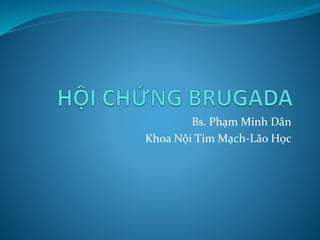Hß╗śI CHß╗©NG BRUGADA
- 1. Bs. Phß║Īm Minh D├ón Khoa Nß╗Öi Tim Mß║Īch-L├Żo Hß╗Źc
- 2. LŲ»ß╗óC Sß╗¼ Bß╗åNH ’éŚ N─ām 1992 anh em Brugada m├┤ tß║Ż hß╗Öi chß╗®ng rß╗æi loß║Īn nhß╗ŗp tim di truyß╗ün ─æß║Ęc trŲ░ng bß╗¤i ST ch├¬nh l├¬n ß╗¤ c├Īc chuyß╗ān ─æß║Īo trŲ░ß╗øc tim (P), block nh├Īnh phß║Żi, dß╗ģ rß╗æi loß║Īn nhß╗ŗp vß╗øi cß║źu tr├║c tim b├¼nh thŲ░ß╗Øng. ’éŚ N─ām 2002 ─æŲ░a ra ti├¬u chuß║®n chß║®n ─æo├Īn.
- 3. TI├ŖU CHUß║©N CHß║©N ─ÉO├üN 1. ─ÉT─É: phß╗®c bß╗Ö QRS dß║Īng block nh├Īnh (P), ST ch├¬nh v├▓m tr├¬n 2mV v├Ā s├│ng T ├óm s├óu hŲĪn 1mV ß╗¤ V1, V2, V3 2. K├©m theo ├Łt nhß║źt mß╗Öt trong 5 ti├¬u chuß║®n sau: - C├│ rß╗æi loß║Īn nhß╗ŗp thß║źt ─æa ß╗Ģ hoß║Ęc rung thß║źt ─æ├Ż ─æŲ░ß╗Żc ghi nhß║Łn - Ngß║źt kh├┤ng giß║Żi th├Łch ─æŲ░ß╗Żc nguy├¬n nh├ón - Thß╗¤ ng├Īp (thß╗¤ hß║źp hß╗æi) vß╗ü ─æ├¬m - Th─ām d├│ ─æiß╗ćn sinh l├Į tß║Īo ─æŲ░ß╗Żc cŲĪn nhß╗ŗp nhanh thß║źt hoß║Ęc rung thß║źt - Tiß╗ün sß╗Ł gia ─æ├¼nh c├│ ngŲ░ß╗Øi ─æß╗Öt tß╗Ł do tim dŲ░ß╗øi 45 tuß╗Ģi
- 4. ─Éiß╗åN T├éM ─Éß╗Æ Hß╗śI CHß╗©NG BRUGADA
- 6. TYPE II
- 7. Th─ām d├▓ ─æiß╗ćn sinh l├Ł ’éŚ Chß║╣n k├¬nh Natri ’éŚ Ajmaline ’éŚ Flecainide ’éŚ Procainamide ’é¦Sß╗æt ’é¦Chuyß╗ān ─æiß╗ćn cß╗▒ l├¬n LS 2, 3
- 9. Chß║®n ─æo├Īn ph├ón biß╗ćt ’éŚ Block nh├Īnh (P) kh├┤ng ─æiß╗ān h├¼nh ’éŚ Ph├¼ ─æß║Īi thß║źt tr├Īi ’éŚ T├Īi cß╗▒c sß╗øm ’éŚ Vi├¬m m├Āng ngo├Āi tim cß║źp ’éŚ Nhß╗ōi m├Īu cŲĪ tim cß║źp v├╣ng trŲ░ß╗øc ’éŚ Thuy├¬n tß║»c phß╗Ģi ’éŚ CŲĪn ─æau thß║»t ngß╗▒c Printzmetal ’éŚ T├Īch th├Ānh ─ÉMC ’éŚ T─āng Kali, Calci m├ĪuŌĆ”
- 10. ░õŲĀ CHß║Š Bß╗åNH SINH ’éŚ Gene m├Ż h├│a protein cß╗¦a k├¬nh Na+ tr├¬n m├Āng tß║┐ b├Āo cŲĪ tim bß╗ŗ ─æß╗Öt biß║┐n’āĀ thay ─æß╗Ģi cß║źu tr├║c v├Ā chß╗®c n─āng cß╗¦a K├¬nh Natri’āĀ rß╗æi loß║Īn t├Īi cß╗▒c. ’éŚ Gene di truyß╗ün trß╗Öi SCN5A tr├¬n NST thŲ░ß╗Øng 20-30% (Brugada type I) ’éŚ Ngo├Āi ra c├Īc gene CACNA1C, CACNB2b chiß║┐m khoß║Żng 10% cases ’éŚ HŲĪn nß╗Ła sß╗æ ca kh├┤ng do di truyß╗ün
- 11. ░õŲĀ CHß║Š Bß╗åNH SINH HC BRUGADA
- 12. PH├éN Tß║”NG NGUY ░õŲĀ
- 13. Brugada Syndrome: Report of the Second Consensus Conference by Charles Antzelevitch, Pedro Brugada, Martin Borggrefe, Josep Brugada, Ramon Brugada, Domenico Corrado, Ihor Gussak, Herve LeMarec, Koonlawee Nademanee, Andres Ricardo Perez Riera, Wataru Shimizu, Eric Schulze-Bahr, Hanno Tan, and Arthur Wilde Circulation Volume 111(5):659-670 February 8, 2005 Copyright ┬® American Heart Association, Inc. All rights reserved.
- 14. Figure 7. Kaplan-Meier curve of effectiveness of the ICD in 258 patients with ECG pattern of Brugada syndrome according to symptoms. Charles Antzelevitch et al. Circulation. 2005;111:659-670 Copyright ┬® American Heart Association, Inc. All rights reserved.
- 15. ─ÉIß╗ĆU TRß╗Ŗ ’éŚ M├Īy ph├Ī rung cß║źy trong ngŲ░ß╗Øi: ICD
- 16. Figure 8. Indications for ICD implantation in patients with Brugada syndrome. Charles Antzelevitch et al. Circulation. 2005;111:659-670 Copyright ┬® American Heart Association, Inc. All rights reserved.
- 17. Figure 8. Indications for ICD implantation in patients with Brugada syndrome. Charles Antzelevitch et al. Circulation. 2005;111:659-670 Copyright ┬® American Heart Association, Inc. All rights reserved.
- 18. T├Āi liß╗ću tham khß║Żo ’éŚ B├Āi giß║Żng PGS. TS Phß║Īm Nguyß╗ģn Vinh. ’éŚ Cardiology an illustrated textbook 2013 ’éŚ Brawnwald Heart Disease 10th edition 2015 ’éŚ Brugada Syndrome: Report of the Second consensus Conference, 2005, Endorsed by the Heart Rhythm Society and the European Heart Rhythm Association
- 19. TR├éN TRß╗īNG Cß║óM ŲĀ▒Ę!
Editor's Notes
- #15: Figure 7. Kaplan-Meier curve of effectiveness of the ICD in 258 patients with ECG pattern of Brugada syndrome according to symptoms. Data are from the multicenter registry of 690 patients with Brugada syndrome.
- #17: Figure 8. Indications for ICD implantation in patients with Brugada syndrome. Class I designation indicates clear evidence that the procedure or treatment is useful or effective; Class II, conflicting evidence about usefulness or efficacy; Class IIa, weight of evidence is in favor of usefulness or efficacy; and Class IIb, usefulness or efficacy is less well established. BS indicates Brugada syndrome; NAR, nocturnal agonal respiration; and SCD, sudden cardiac death.
- #18: Figure 8. Indications for ICD implantation in patients with Brugada syndrome. Class I designation indicates clear evidence that the procedure or treatment is useful or effective; Class II, conflicting evidence about usefulness or efficacy; Class IIa, weight of evidence is in favor of usefulness or efficacy; and Class IIb, usefulness or efficacy is less well established. BS indicates Brugada syndrome; NAR, nocturnal agonal respiration; and SCD, sudden cardiac death.












































































![[CD6.52] Bao ve tim thß║Łn.pdf](https://cdn.slidesharecdn.com/ss_thumbnails/cd6-231001022337-55ff859e-thumbnail.jpg?width=560&fit=bounds)










